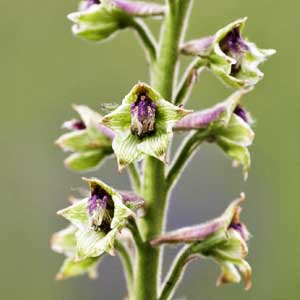Delphinium viridescens
Delphinium menziesii
Wenatchee larkspur
Menzies' larkspur
90-150 cm;
base usually green, glabrous.
(10-)35-70(-85) cm;
base often reddish, puberulent.
blade cuneate to semicircular, 2-5 × 3-12 cm, nearly glabrous; ultimate lobes 3-21, width 1-8 mm.
blade round, 1.5-5 × 3-9 cm, puberulent; ultimate lobes 5-18, width 2-15 mm (basal), 1-10 mm (cauline), widest at middle or in proximal 1/2.
25-80-flowered, dense;
pedicel 0.5-2 cm, glandular-pubescent;
bracteoles 1-4 mm from flowers, green, lanceolate, 3.5-6 mm, glandular-pubescent.
3-15(-43)-flowered;
pedicel 1.5-4(-7) cm, (glandular) puberulent;
bracteoles 8-10(-24) mm from flowers, green to blue, linear, 4-6(-9) mm, puberulent.
sepals yellowish green, nearly glabrous, lateral sepals forward pointing, 7-9 × 3-4 mm, spurs decurved, 30-45° below horizontal, often hooked apically, 8-11 mm;
lower petal blades ± covering stamens, 4-6 mm, clefts 0.5-1.5 mm;
hairs centered, mostly near junction of blade and claw, yellow.
sepals bluish purple or yellowish, often partly fading upon drying, puberulent, lateral sepals spreading, (11-)13-20 × 5-11 mm, spurs straight, ascending less than 30° above horizontal, 11-17 mm;
lower petal blades ± covering stamens, 8-12 mm, clefts 0.2-2.5 mm;
hairs sparse, centered, mostly near junction of blade and claw above base of cleft, white or blue.
8-11 mm, 2.5-3 times longer than wide, puberulent.
11-17 mm, 3.5-4 times longer than wide, puberulent.
± wing-margined;
seed coat cells with surfaces ± roughened.
wing-margined;
seed coat cell surfaces smooth, without swollen blunt hair.
Delphinium viridescens
Delphinium menziesii
Of conservation concern.
Delphinium viridescens is local in mountains southwest of Wenatchee, Washington.
(Discussion copyrighted by Flora of North America; reprinted with permission.)
Subspecies 2 (2 in the flora).
Although Delphinium menziesii has often been confused with D. nuttallii, it may be distinguished by its consistently larger flowers and usually fewer flowers per plant. Interestingly, each species produces both blue-purple and yellowish flower colors in separate populations.
The Chehalis consider Delphinium menziesii poisonous, but they also apply it to sores. The women of the Thompson Indians use it as a love charm (D. E. Moerman 1986, subspecies not indicated).
(Discussion copyrighted by Flora of North America; reprinted with permission.)
1. Sepals blue to purple. | subsp. menziesii |
1. Sepals yellowish to white. | subsp. pallidum |


